|
|
||||||||||||||||||||||||||||||||||||||||
|
|
July 2007
The lost
art of album covers
By Dan DeMuth
I am straying somewhat here, but my
point is the loss of a type of
connectivity we had with the musician
and the musical theme with the demise of
record albums and
The Decca label released a series of LPs
with the
So what’s the tradeoff? Better sound but
with the need of a magnifying glass just
to read the liner notes? No artwork to
stir up the gray matter? Things are
supposed to get better with age, but
hell, it’s hard to find a bartender
anymore who knows how to make a decent
Manhattan. Ain’t progress grand?
"The Music of Buddy DeFranco,"
cover by David Stone Martin
"The Ink Spots,"
cover by Arthur Shilstone
"The Swingin' '30s,"
cover by Tracy Sugarman
"Jazz at the Philharmonic, Vol.
15,"
cover by David Stone Martin
"He Like to Go Dancing,"
cover by George Petty
"Jazz at the Philharmonic, Vol.
9,"
cover by David Stone Martin
"Beethoven Trios," cover
reproduction of famous artwork
"Progressive Jazz,"
cover by David Stone Martin
Sarah Vaughan's "Hot Jazz,"
cover by unknown artist
Former prairie boy turns mountain man By Tom
Ineck In his
lifetime, Andrew Vogt has evolved quite naturally—and without a
plan—from a child of the Plains to a man of the Rocky Mountains, with a
three-year detour to the Caribbean aboard a series of Carnival cruise
ships.
Vogt came
up through the Lincoln Public Schools system, which has a long history
of high-quality music education. But his earliest influence was closer
to home. “My dad has
been a jazz fan for many, many years,” Vogt recalled in a recent phone
interview from his home. “I think he went to see Dave Brubeck live way
back when, and he had a really nice record collection of Cannonball
Adderley, Brubeck, Stan Getz. He has the soundtrack, on vinyl, to
‘Breakfast at Tiffany’s,’ by Henry Mancini. It’s a sweet album. I have
it on cassette, and I cherish that record. I loved it back then, when I
didn’t know what the heck they were doing, and I still love it. I
listened to it the other day.” He also ranks the recordings of
saxophonists Art Pepper and Zoot Sims among his favorites. Several
longtime Lincoln jazz musicians and educators had an early impact,
including saxophonists Ed Love and Scott Vicroy and the early version of
the Nebraska Jazz Orchestra, then called the Neoclassic Jazz Orchestra.
When he entered the University of Nebraska-Lincoln School of Music, he
came under the influence of saxophonist Dave Sharp, who helped him land
some of his first commercial gigs. And, Vogt feels especially close to
Lincoln keyboard whiz, teacher and friend John Carlini. Vogt, too,
is an educator, running instrumental programs for a few hours a week at
local Catholic and Lutheran schools and maintaining a studio for
individual instruction. Cruise ship
life can have its ups and downs—including officers who show little
respect and audiences who all but ignore you—but Vogt considers himself
luckier than most jazz musicians during his own extended maritime
period. “My review
of my experience is much more positive than most musicians,” he said. “I
was fortunate to be able to work on ships that were more jazz-oriented,
and I was fortunate to work with this piano player named Murray Jackman,
who was a retired five-star admiral. He had hands the size of elephants
and sounded like three Oscar Petersons in one. He knew a million tunes,
and we got to be good friends.”
“You do
your stint. It’s time to move on. It’s sort of like not reality out
there.” In
retrospect, his career moves seem logical, even calculated, but Vogt
insists he doesn’t make plans. “It wasn’t
really like a plan of mine or anything,” he says, laughing. “Most times,
when I seem to make a plan, it doesn’t really work out that way.” Vogt’s
parents first made the move from Nebraska to Colorado quite a few years
ago, so between cruise ship jobs, Andrew would visit his family. He soon
grew very fond of the natural setting and the jazz-friendly climate. “I just
love it out here,” Vogt said. “I’m kind of a mountain boy, really. I
love to go hiking. I love Colorado and the Front Range and living in
Fort Collins. You’ve got Boulder and Denver nearby and other areas and
all these resort towns, up in the mountains. There are gigs flying all
over the place!” “It just
kind of happened this way, you know!” he tries to explain, as though his
good fortune—absent a plan—surprises even him. “It’s a nice blend. I’m
not really a coast kind of kind. I’m a little bit of a hick. I just love
the Midwest, but yet I also like getting up into these higher
elevations, where the humidity isn’t so heavy. It’s just a ball out
here, and I’m having a great time.” Some of the
fun is in being able to play with world-class musicians, some who are
natives of the area and some, like Vogt, who have migrated to the
mountains from other parts of the country. The area seems especially
fertile ground for keyboard players. “There are
some fantastic players in this Boulder-Fort Collins-Denver area,
particularly piano players, and I’ve always had a real connection with
piano players,” Vogt said. Many of the best players are products of the
area’s music schools, both teachers and students. The University of
Northern Colorado at Greeley has produced the best big band in the
country for the last couple of years, he said, and there also are
significant jazz music programs at the University of Denver, the
University of Colorado at Boulder and Colorado State University in Fort
Collins.
The names
of bands and styles of music shift almost as frequently as the venues.
Depending on the occasion, Vogt might take the stage with Mark Sloniker
and friends, the funk-rock Jonny Mogambo Band, the Swing Essence
Quartet, Big Black Cadillac or fronting his own trio or quartet. “There are
half a dozen regular groups that I’m first-call for, and there are other
things that come up, too,” he said, describing the typical frenetic pace
of a versatile, sought-after saxophonist. Vogt keeps track of his
upcoming performances with regular updates on his new website at
www.drewsblues.com, which also contains the requisite biography,
discography, news coverage, media photographs and contact information.
Most
exciting for Vogt’s creative side is the recent formation of a quartet
featuring Vogt’s horns, in addition to guitar, bass and drums and
tentatively called ZARO, after the first names of the players. They have
been rehearsing new tunes in the hopes of establishing a long-term
relationship, every jazz musician’s dream. “There are
so many gigs that I play where I just step in and do it right now,” Vogt
said. “You’ve got to hit it right on the spot. That’s how it is with a
lot of jazz players.” Unlike that off-the-cuff, impromptu performance
ethic, the more democratic and dedicated ZARO presents a clearer path
for artistic growth. “We
rehearse Sundays, early in the afternoon. We’re trying to put together a
whole bunch of unusual stuff, progressive stuff, tricky stuff that you
wouldn’t call on a gig. That requires rehearsal. It’s an opportunity for
me to work with more original material. We’re putting together all kinds
of crazy stuff.” That is not
to say that Vogt doesn’t appreciate the jazz standards and blues
progressions that form the core of every professional jazz musician’s
play list. “I love the
doing the standards. At the same time, it’s just great to get together
with some guys and just rehearse, put together our dream music.” The
band already has a couple of bookings in August, including the three-day
NewWestFest, which annually draws more than 100,000 people to downtown
Fort Collins. “It’s a
gradual work-in-progress, but the idea is that we’re going to be playing
a lot, hopefully doing more festivals. There are a lot of festivals in
the mountains that we can take advantage of.”
Vogt claims
that his latest release and his first as a leader, “Action Plan,” is the
only plan he’s ever had that came to fruition as imagined. It features
other Rocky Mountain greats Rich Chiaraluce on reeds, pianist Mark
Sloniker, bassist Eric Applegate and drummer Mark Raynes, in addition to
trumpeter Kevin Whalen on two tracks. For a review of the CD,
click
here. He’s
already at work on the next recording. “I’m
sitting down at the piano and working out ideas quite a bit,” Vogt said.
“I hope to be in the studio this fall to do some more stuff and get the
next disc out.” That sounds
suspiciously like a plan.
Musical treasure awaits at end of the
road
By Tom Ineck
Such was the case June 24, when Butch
and Grace Berman, my wife, Mary Jane,
and I headed to the Brownville Concert
Hall for a 2 p.m. performance featuring
Klea Blackhurst and Billy Stritch in
“Dreaming of a Song,” their
collaborative tribute to the music of
Hoagy Carmichael.
Certainly the musical professionalism
was aided by bassist Gerald Spaits and
drummer Ray DeMarchi, who drove up from
their homes in Kansas City, Mo., to
accompany the duo. Stritch, a brilliant
pianist, singer, musical supervisor and
arranger who has worked with Liza
Minnelli, Charles Aznavour and others,
had written the charts will little room
for improvisational forays, and Spaits
and DeMarchi delivered note-perfect
performances throughout the 90-minute
show.
Many listeners were familiar with such
Carmichael classics as “Georgia on My
Mind,” “Stardust,” “Skylark,” “The
Nearness of You,” “I Get Along Without
You Very Well,” and “In the Cool, Cool,
Cool of the Evening,” but the 22-song
play list also contained little-known
gems like “One Morning in May,” “When
Love Goes Wrong,” and “My Resistance is
Low.” In their informal introductions,
Blackhurst and Stritch also provided
interesting, often humorous background
on the composer and his tunes.
On “Lazy River,” Stritch did the
vocalizing while Blackhurst showed her
instrumental prowess by providing rhythm
accompaniment on the ukulele, giving the
tune an appropriately old-time quality.
Blackhurst and Stritch still are
developing the thematic Carmichael
program and plan to record a well-honed
version this fall. Those lucky enough to
catch one of the Brownville performances
witnessed a stunning work-in-progress.
Planned book proves that "Louisiana
Rocks"
Editor’s Note: The
following is an excerpt from "Louisiana
Rocks: The True Genesis of Rock and
Roll," an unpublished 560-page
manuscript by Tom Aswell of Denham
Springs, La. As the writer shops the
manuscript to prospective publishers, he
has suggested that the Berman Music
Foundation feature pieces from the book.
We begin with the entry on the Boogie
Kings, a band that was featured here
several years ago with writings
submitted by Boogie Kings member Ned
Theall. Readers who wish to correspond
with Aswell can reach him by e-mail at
azspeak@bellsouth.net.
Band members comprised an honor roll of
Louisiana swamp pop, some of whom had
major hits as solo artists: Bert Miller,
Tommy McLain ("Sweet Dreams"), Clint
West ("Big Blue Diamonds," "Try To Find
Another Man"), G.G. Shinn, Ned Theall,
Dwayne Yates, Jerry Lacroix, Linda
Clark, Norris Badeaux, Mike Pollard,
Murphy Buford, Dan Silas, and Doug
Ardoin. The horn section alone was
nothing short of spectacular.
The band, which had never played outside
Acadiana, purchased seven different
tuxedos for each band member—one for
each day of the week—and began seeking
bookings in Houston and New Orleans.
While they were packing the houses in
those two markets, a Las Vegas agent
booked them into Reno, Tahoe, Vegas,
Hollywood and San Francisco.
In Hollywood, The Righteous Brothers
were in the audience and after the show
Bill Medley and Bobby Hatfield
approached the band members and
congratulated them for their show.
On another occasion, the band was booked
into Ball’s Auditorium in Houston before
an all-black audience. B.B. King did the
first show and stayed around to hear the
Boogie Kings before a packed house.
After the band had played a few songs,
Reginald Ball, owner of the auditorium,
came onstage to say that King wanted to
join the band for a few songs. The crowd
was already going crazy for the Boogie
Kings and when B.B. joined them,
pandemonium reigned and the more
enthusiastic the crowd got, the better
the band played and the better the band
played, the more enthusiastic the crowd
became. Afterwards, King told them they
were the blackest band he’d ever heard.
Drugs, pills, booze, and women were
beginning to take their toll on the band
that, because its initial album was
released as “Clint West and the Boogie
Kings,” now had West as its ex-officio
leader. At the same time, West, who was
having marital problems, was beginning
to miss occasional gigs, much to the
growing consternation of other band
members. One fateful night, the band was
booked into the Continental Club in
Beaumont and West had not shown up. Ned
Theall was sitting on the organ bench at
nine o’clock cursing the fact that there
was no drummer and, consequently, no
show, when a kid walked up and asked,
“What’s wrong?”
Theall tried to explain that the boy
wouldn’t understand but he was
persistent, so he told him, “Our drummer
didn’t show up and we can’t play without
a drummer.”
“I can cut the gig,” the kid, an albino,
said.
Theall told him he was too young to
understand the band’s music. Again, he
said, “I can cut the gig.”
“How long you been playing drums?” asked
Theall.
“I’m not a drummer, I’m a trumpet
player, but I can cut the gig.”
“What’s your name?” Theall asked, by now
intrigued at the kid’s confidence that
bordered on cockiness, as well as his
stubborn streak.
"Edgar Winter.”
Theall told him he had one shot, that
he’d let him play one song and if he
proved good enough, he could play the
gig. His instincts told him to give the
kid a chance. The difficulty lay in
convincing skeptical band members.
Sensing deep down that Winter really was
capable of playing the gig, Theall let
him sit in. He was right. Winter aced
the test on the first song and stayed
on, never missing a beat all night and
in the opinion of at least some of the
band members, played better than West on
some of the songs.
All good things must end and the band
members grew increasingly disenchanted
with West’s leadership or lack of
leadership, as the case may have been.
The Moulin Rouge Club made Clint an
offer of a partnership with the club
splitting the profits fifty-fifty, with
West getting 20 percent of the fifty and
the band to split the remaining 30
percent. The band was the house band for
the Bamboo Club so a vote was taken at
the end of 1964. West had to reject the
Moulin Rouge offer and return to the
Bamboo, or leave the band. Theall gave
him the news right after a New Year’s
Eve show and West subsequently left the
band.
A lengthy legal fight over use of the
Boogie Kings name ensued with Theall
eventually winning out. West signed with
Floyd Soileau’s Swallow record label in
Ville Platte while the remainder of the
band went with S.J. Montalbano’s Montel
Records in Baton Rouge. And the band(s)
played on.
Editor’s Note:
At your request, we will mail a printed version
of the newsletter. The online newsletter also is available at this
website in pdf format for printing. Just click here: Newsletter

April 2007
January 2007
Articles 2006
Articles 2005
Articles 2004
Articles 2003
Articles 2002
Feature Articles
Music news, interviews, opinion
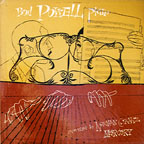 While
one sure as hell can’t stop technology,
it’s still OK to lament the loss of the
more personal side of what it replaced.
Miniaturization is the thing, of thee
I sing. Don’t want practicality,
just give me the bling. Can we be
far away from speaking into a cellular
receiver, and having it convert to a
text message to avoid meaningful
conversation? Wouldn’t that be full
circle? Can electronic gadgets be made
with buttons any smaller as to be more
useless than they now are?
While
one sure as hell can’t stop technology,
it’s still OK to lament the loss of the
more personal side of what it replaced.
Miniaturization is the thing, of thee
I sing. Don’t want practicality,
just give me the bling. Can we be
far away from speaking into a cellular
receiver, and having it convert to a
text message to avoid meaningful
conversation? Wouldn’t that be full
circle? Can electronic gadgets be made
with buttons any smaller as to be more
useless than they now are?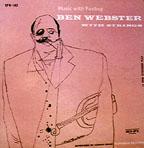 their
cover artwork. Forget for a moment the
continuing debate between the purists,
those who lament the ‘harsher or
clearer’ sound of a CD versus the
‘softer more pliable’ sound of vinyl and
the techies who snort in derision.
Technology has given us cleaner sounds,
especially with re-mastered older
recordings, so there is a trade-off. And
yes, the smaller unit is easier to
store, both for the listener and the
retailer and can be taken places and
played that would be impossible with
vinyl. But in the process we have lost
the opportunity to easily read large
liner notes, view detailed photos and
gaze upon beautiful, innovative and
creative artwork. Even some seven-inch,
45 rpm jazz EPs still offered a decent
look of the matching, larger 12-inch LP
from which they were culled. Anything
smaller (CD, cassette, etc.) is
virtually a lost cause. Finding great
art on a CD cover is like going to the
Louvre to look at postage stamps.
their
cover artwork. Forget for a moment the
continuing debate between the purists,
those who lament the ‘harsher or
clearer’ sound of a CD versus the
‘softer more pliable’ sound of vinyl and
the techies who snort in derision.
Technology has given us cleaner sounds,
especially with re-mastered older
recordings, so there is a trade-off. And
yes, the smaller unit is easier to
store, both for the listener and the
retailer and can be taken places and
played that would be impossible with
vinyl. But in the process we have lost
the opportunity to easily read large
liner notes, view detailed photos and
gaze upon beautiful, innovative and
creative artwork. Even some seven-inch,
45 rpm jazz EPs still offered a decent
look of the matching, larger 12-inch LP
from which they were culled. Anything
smaller (CD, cassette, etc.) is
virtually a lost cause. Finding great
art on a CD cover is like going to the
Louvre to look at postage stamps.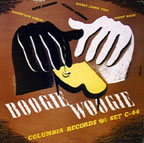 Some
of the best-known contributors to album
art were author and photographer Burt
Goldblatt, who was responsible for more
than 3,000 covers; David Stone Martin,
to whom more than 250 covers are
attributed; Tracy Sugarman, who
contributed to more than 100 covers; and
perhaps to a lesser degree, Arthur
Shilstone. The latter two had very
distinguished military careers in WWII.
Shilstone went on to become a noted
illustrator for many magazines and even
NASA, his contributions illustrating LP
covers being a little-known facet of his
career.
Some
of the best-known contributors to album
art were author and photographer Burt
Goldblatt, who was responsible for more
than 3,000 covers; David Stone Martin,
to whom more than 250 covers are
attributed; Tracy Sugarman, who
contributed to more than 100 covers; and
perhaps to a lesser degree, Arthur
Shilstone. The latter two had very
distinguished military careers in WWII.
Shilstone went on to become a noted
illustrator for many magazines and even
NASA, his contributions illustrating LP
covers being a little-known facet of his
career. 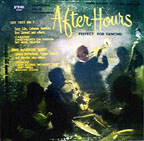 These
artists named are but a few who
contributed to this era. Great album art
was not limited to jazz, and didn’t
start with the LP issues. Some 78 rpm
album sets were graced with covers
relating to what could be found inside.
Some bore artwork relevant to the
musicians to be heard and the
instruments featured. As an example,
David Stone Martin created a 78 rpm
cover, circa 1950, which depicts Art
Tatum at the piano, with only drawings
of the guitar of Tiny Grimes and the
bass of Slam Stewart, the obvious
analogy being that legally blind Tatum
needed only to hear the other two trio
members.
These
artists named are but a few who
contributed to this era. Great album art
was not limited to jazz, and didn’t
start with the LP issues. Some 78 rpm
album sets were graced with covers
relating to what could be found inside.
Some bore artwork relevant to the
musicians to be heard and the
instruments featured. As an example,
David Stone Martin created a 78 rpm
cover, circa 1950, which depicts Art
Tatum at the piano, with only drawings
of the guitar of Tiny Grimes and the
bass of Slam Stewart, the obvious
analogy being that legally blind Tatum
needed only to hear the other two trio
members. 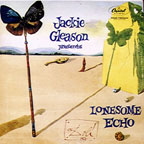 Classical
LPs would occasionally depict a perhaps
avant-garde persona of the theme to be
heard, and often sported reproductions
of famous works of art on the covers.
Classical
LPs would occasionally depict a perhaps
avant-garde persona of the theme to be
heard, and often sported reproductions
of famous works of art on the covers.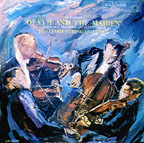 In the jazz idiom labels such as
Bethlehem, Clef, Grand Award, Norgran,
Prestige and Verve were the more
frequent users of this art, but
occasionally even a mainstream company
such as Capitol would venture into the
surreal, such as the 1955 cover of
"Lonesome Echo," a Jackie Gleason album
with Salvador Dali artwork.
In the jazz idiom labels such as
Bethlehem, Clef, Grand Award, Norgran,
Prestige and Verve were the more
frequent users of this art, but
occasionally even a mainstream company
such as Capitol would venture into the
surreal, such as the 1955 cover of
"Lonesome Echo," a Jackie Gleason album
with Salvador Dali artwork.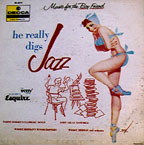 covers
graced with the curvaceous feminine
artwork of George Petty, he of Esquire
Magazine fame for his “Petty Girls”
series. To my knowledge the old adage of
“suitable for framing” was never used
but would certainly have been apropos.
covers
graced with the curvaceous feminine
artwork of George Petty, he of Esquire
Magazine fame for his “Petty Girls”
series. To my knowledge the old adage of
“suitable for framing” was never used
but would certainly have been apropos.
Some more
great album covers...
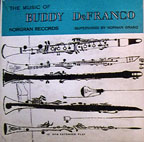
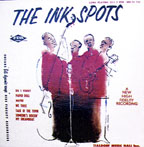
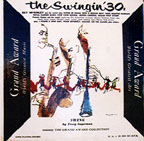
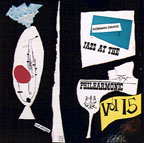
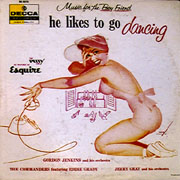
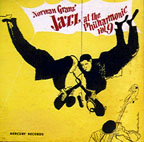
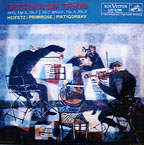
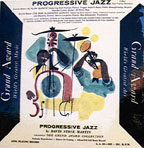
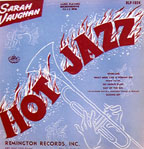
![Andrew Vogt [Photo courtesy Andrew Vogt]](media/707vogt1.jpg) The
multi-talented saxophonist got his start in music as a child in Lincoln,
Neb., where he was influenced by his jazz-loving father and his many
teachers, mentors and musician friends. During his three-year stint
playing the cruise ships, he honed his playing technique and broadened
his knowledge of the bedrock standards that every jazz musician worth
his salt must learn. Since 2000, he has called Fort Collins, Colo., his
home base, making frequent forays to gigs in the surrounding towns and
nearby ski resorts.
The
multi-talented saxophonist got his start in music as a child in Lincoln,
Neb., where he was influenced by his jazz-loving father and his many
teachers, mentors and musician friends. During his three-year stint
playing the cruise ships, he honed his playing technique and broadened
his knowledge of the bedrock standards that every jazz musician worth
his salt must learn. Since 2000, he has called Fort Collins, Colo., his
home base, making frequent forays to gigs in the surrounding towns and
nearby ski resorts.![Andrew Vogt at work [Photo courtesy Andrew Vogt]](media/707vogt3.jpg) Besides,
the snorkeling was good and the Hungarian barmaids were beautiful. Even
so, Vogt decided after three years at sea that he had had enough.
Besides,
the snorkeling was good and the Hungarian barmaids were beautiful. Even
so, Vogt decided after three years at sea that he had had enough.![Vogt blowing tenor sax on a gig [Photo courtesy Andrew Vogt]](media/707vogt2.jpg) With
more than 40 summer gigs scheduled for a wide array of venues and bands,
Vogt says his dog-eared playing calendar is second only to the Bible in
his esteem. His busy schedule ranges from regular performances at clubs
like Jay’s Bistro in Fort Collins’ Old Town section to dance parties at
the local swimming pool and private affairs at the country club to
venues farther afield, like Finnegan’s Wake in Avon, the Blue River
Bistro in Breckenridge, the Culture Club in Steamboat Springs,
Spendido’s in Beaver Creek, the Stanley Hotel in Estes Park, and
Snowville in Vail.
With
more than 40 summer gigs scheduled for a wide array of venues and bands,
Vogt says his dog-eared playing calendar is second only to the Bible in
his esteem. His busy schedule ranges from regular performances at clubs
like Jay’s Bistro in Fort Collins’ Old Town section to dance parties at
the local swimming pool and private affairs at the country club to
venues farther afield, like Finnegan’s Wake in Avon, the Blue River
Bistro in Breckenridge, the Culture Club in Steamboat Springs,
Spendido’s in Beaver Creek, the Stanley Hotel in Estes Park, and
Snowville in Vail. ![Vogt (right) with Rich Chiaraluce [Photo courtesy Andrew Vogt]](media/707vogtrich.jpg) Vogt
is featured on several recordings, including the excellent 2003 release
by the Jason Hollar Jazz Quartet. Hollar, a bassist, wrote some of the
tunes, but it was Vogt who dominated the proceedings on alto, tenor and
baritone saxes and clarinet. For a review of that CD,
click
here.
Vogt
is featured on several recordings, including the excellent 2003 release
by the Jason Hollar Jazz Quartet. Hollar, a bassist, wrote some of the
tunes, but it was Vogt who dominated the proceedings on alto, tenor and
baritone saxes and clarinet. For a review of that CD,
click
here.
![Klea Blackhurst [Courtesy Photo]](media/707blackhurst.jpg) BROWNVILLE,
Neb.—The 80-mile road trip from Lincoln
to this quaint Missouri River town in
southeast Nebraska is always an
adventure, especially when it involves
compatible travel companions and a
world-class concert at the end of the
road.
BROWNVILLE,
Neb.—The 80-mile road trip from Lincoln
to this quaint Missouri River town in
southeast Nebraska is always an
adventure, especially when it involves
compatible travel companions and a
world-class concert at the end of the
road.![Billy Stritch [Courtesy Photo]](media/707stritch.jpg) As
arranged by Stritch, the music was not
jazz in the strict sense of the word,
but the type of well-staged musical
theater presentation that you might
expect in an intimate Broadway theater,
a classy New York City supper club or an
upscale hotel lounge. Throughout their
three-day booking—with evening cabaret
shows on Friday and Saturday, in
addition to the Sunday
matinee—Blackhurst and Stritch delivered
the goods with thorough professionalism,
despite the incongruity of performing in
a quiet backwater burg like Brownville,
Nebraska’s oldest town.
As
arranged by Stritch, the music was not
jazz in the strict sense of the word,
but the type of well-staged musical
theater presentation that you might
expect in an intimate Broadway theater,
a classy New York City supper club or an
upscale hotel lounge. Throughout their
three-day booking—with evening cabaret
shows on Friday and Saturday, in
addition to the Sunday
matinee—Blackhurst and Stritch delivered
the goods with thorough professionalism,
despite the incongruity of performing in
a quiet backwater burg like Brownville,
Nebraska’s oldest town.![Blackhurst on ukulele [Courtesy Photo]](media/707blackhurst3.jpg) Both Blackhurst and Stritch are
excellent singers and complement each
other’s styles. Known for her Ethel
Merman tributes, Blackhurst can belt it
out with a verve and gusto reminiscent
of that iconic songstress, especially on
jazzy numbers like “Doctor, Lawyer,
Indian Chief,” “Riverboat Shuffle” and
“Ain’t There Anyone Here for Love.”
Stritch kept a firm grasp on the
harmonic helm at the grand piano, while
also harmonizing vocally and
occasionally taking the spotlight, such
as a lively take on “Georgia,” a lovely
“Stardust” and a rocking rendition of
“The Old Music Master,” where he also
displayed his considerable piano chops.
Both Blackhurst and Stritch are
excellent singers and complement each
other’s styles. Known for her Ethel
Merman tributes, Blackhurst can belt it
out with a verve and gusto reminiscent
of that iconic songstress, especially on
jazzy numbers like “Doctor, Lawyer,
Indian Chief,” “Riverboat Shuffle” and
“Ain’t There Anyone Here for Love.”
Stritch kept a firm grasp on the
harmonic helm at the grand piano, while
also harmonizing vocally and
occasionally taking the spotlight, such
as a lively take on “Georgia,” a lovely
“Stardust” and a rocking rendition of
“The Old Music Master,” where he also
displayed his considerable piano chops.
![Brownville Concert Hall [Courtesy Photo]](media/707brownvillehall.jpg) Now
in its 17th season, the
Brownville Concert Series continues to
offer world-class artists in an
attractive venue
that respects their artistry. I have
attended several superb performances at
the concert hall (formerly a church) over the years,
including appearances by jazz pianist
Joe Cartwright in 1992, classical
pianist Ian Hobson in 1993, jazz
trumpeter Warren Vache in 1994, jazz
saxophonist Bobby Watson in 1997 and
jazz singer Tierney Sutton in 2005. The
room’s excellent acoustics make it
ideal for jazz and classical music and
guarantee a memorable listening
experience. Bravo!
Now
in its 17th season, the
Brownville Concert Series continues to
offer world-class artists in an
attractive venue
that respects their artistry. I have
attended several superb performances at
the concert hall (formerly a church) over the years,
including appearances by jazz pianist
Joe Cartwright in 1992, classical
pianist Ian Hobson in 1993, jazz
trumpeter Warren Vache in 1994, jazz
saxophonist Bobby Watson in 1997 and
jazz singer Tierney Sutton in 2005. The
room’s excellent acoustics make it
ideal for jazz and classical music and
guarantee a memorable listening
experience. Bravo!
![Boogie Kings [File Photo]](media/707boogiekings.jpg) The
Boogie Kings began as a group back
in the mid-fifties in the little
seventies town of Eunice. Little did
anyone know then that the band would
endure despite changes in personnel and
musical tastes as well as internal
turmoil and lawsuits over the band’s
name. But as the new millennium dawned,
they were still rocking, bigger than
ever as one of the greatest bands never
to have a hit record. From the beginning
the band built a following in seventies
and the Texas Golden Triangle area of
Beaumont, Port Arthur, and Orange—a
following that remains loyal to their
music.
The
Boogie Kings began as a group back
in the mid-fifties in the little
seventies town of Eunice. Little did
anyone know then that the band would
endure despite changes in personnel and
musical tastes as well as internal
turmoil and lawsuits over the band’s
name. But as the new millennium dawned,
they were still rocking, bigger than
ever as one of the greatest bands never
to have a hit record. From the beginning
the band built a following in seventies
and the Texas Golden Triangle area of
Beaumont, Port Arthur, and Orange—a
following that remains loyal to their
music.